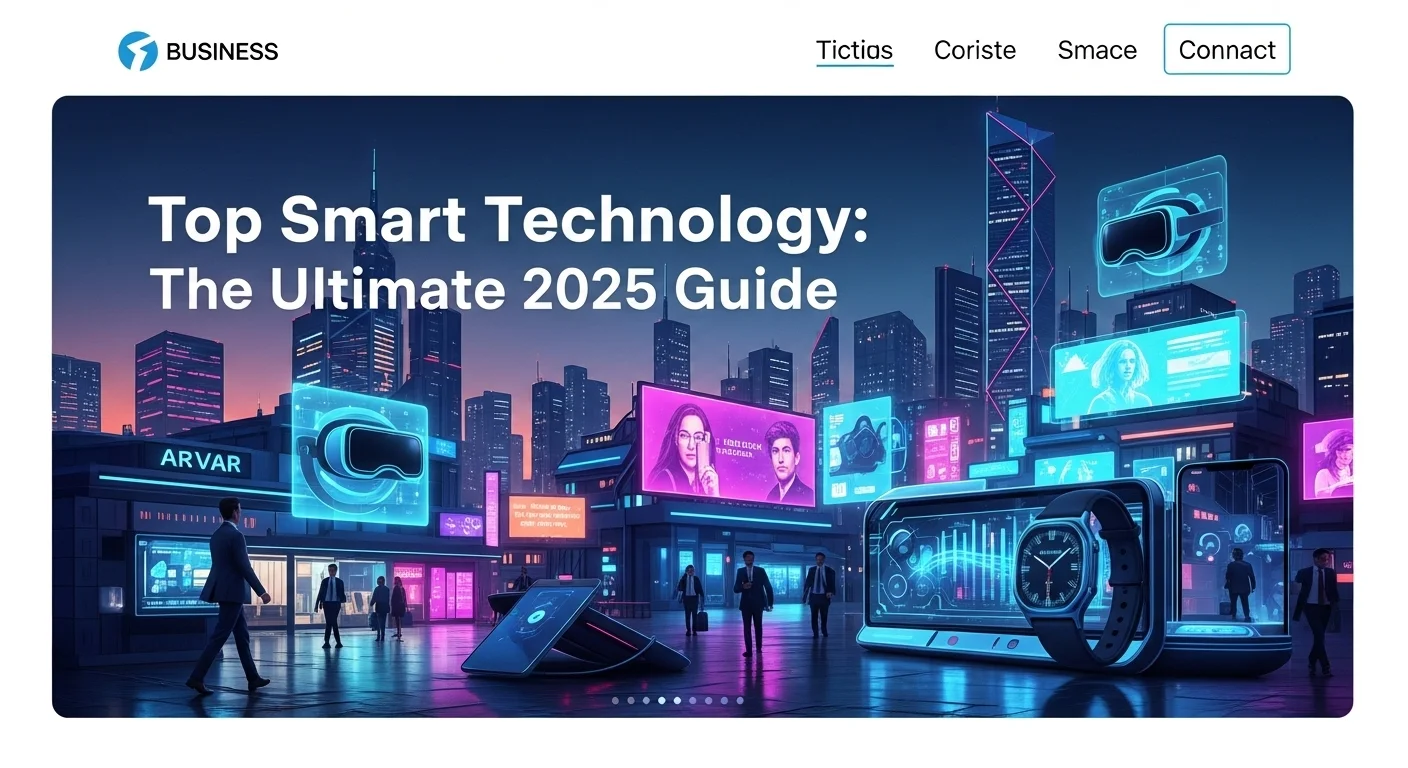Smart Technology in 2025: My Personal Guide to a Truly Connected Home & Business

Executive Summary
Over the past decade, I've seen 'smart technology' go from a niche hobby for tech enthusiasts to something that touches nearly every part of our lives. But let's be honest, there's a huge difference between a collection of gadgets and a truly 'smart' environment. When it works, it's like magic—your home anticipates your needs, and your business runs with incredible efficiency. When it doesn't, it's just a source of frustration. My goal with this guide is to cut through the hype and share what I've learned from years of hands-on experience. We'll look at the smart home ecosystems that actually make life easier, explore how businesses are using this tech to get ahead, and I'll give you my personal, road-tested advice for creating a connected future that works for you.
Table of Contents
- What is Smart Technology, Really?
- The Real Magic: My Take on Smart Home Systems
- Calling in the Pros: Top Smart Home Automation Companies
- A Complete Guide to Smart Tech in Your Home and Business
- My Comparison of the Best Smart Home Systems
- Smart Technology as a Business Superpower
- My Personal Tips for a Better Smart Experience
- The Non-Negotiable Guide to Smart Home Security
What is Smart Technology, Really?
In my line of work, I've connected everything from coffee makers to entire office buildings. 'Smart technology' isn't about having a phone that can turn on a light bulb. It's about creating a responsive ecosystem where your devices communicate and work together, often without you even having to ask. It’s powered by a combination of the Internet of Things (IoT)—the network of physical devices with sensors—and smart software, like Artificial Intelligence (AI), that can learn from your habits. This technology is so important because it's shifting us from using passive tools to having proactive partners. It can automate the boring stuff, give us useful insights from data, and build environments that are safer, more comfortable, and way more efficient. For me, that's the real meaning of 'smart'.
Think of the IoT devices as the eyes and ears, and the AI as the brain. A sensor on a window is just a sensor. But when it's connected to a system that can text you if the window is open while the air conditioning is running and you're not home, that’s when it becomes truly smart. This is where the magic happens. For you at home, this means saving money on your energy bill and feeling more secure. For a business, it's a total game-changer, leading to streamlined operations, lower costs, and happier customers. I've seen it transform businesses firsthand.
The Real Magic: My Take on Smart Home Systems
The smart home is where this technology becomes personal. It’s the best place to see how an interconnected system can genuinely improve your daily life. People are always asking me, 'What's the best smart home system?' The truth is, it depends on what you want to achieve. The heart of any modern smart home is a central hub or voice assistant, like Amazon's Alexa, Google Assistant, or Apple HomeKit. These aren't just speakers that play music; they're the conductors of your home's orchestra. I'll never forget the first time I set up a 'Goodnight' routine for a client. With one command, the doors locked, the security system armed, the lights faded out, and the thermostat lowered. That's the 'wow' moment when people see the true potential.
When people look for the best systems, they're really looking for reliability, ease of use, and compatibility. You want a system that works seamlessly with great products like Philips Hue for lighting, Ring or Arlo for security, and Nest or Ecobee for climate control. The competition is intense, which is great for us because it means companies are constantly improving the user experience and, thankfully, focusing more on security and privacy. A top-tier system feels effortless and trustworthy.
If you're narrowing down your options, you'll likely focus on the big ecosystems from Google, Amazon, and Apple. They have the resources to build comprehensive platforms with tons of compatible devices. And this is about more than just convenience. A well-designed smart thermostat can pay for itself in energy savings. Integrated cameras and locks offer incredible peace of mind, especially when you're away. I've also had the privilege of setting up systems for elderly clients, and the impact is profound. For them, voice control isn't a luxury; it's a tool for independence, allowing them to control their environment and call for help with ease.
Calling in the Pros: Top Smart Home Automation Companies
While DIY smart home gear is better than ever, some people want a level of integration that goes way beyond what you can get at a big-box store. This is where professional automation companies like Crestron, Control4, and Savant come in. I see them as the architects of the smart home world. They don't just sell gadgets; they design and install custom, whole-home solutions. Imagine every piece of technology in your home—lighting, shades, audio, video, security, and HVAC—all managed from one beautiful, intuitive interface. That's what they do.
These high-end companies are essential because they're constantly pushing the envelope, developing tech that eventually makes its way to the consumer market. They show us the full potential of a completely unified smart environment. What's fascinating is that the same principles they use in luxury homes are directly applicable to businesses. The system that automates a high-end home theater can be scaled to create a smart hotel, an intelligent boardroom, or a responsive retail space. Understanding both the DIY and pro-level options gives you a complete picture of this incredible, fast-moving field.

A Complete Guide to Smart Tech in Your Home and Business
To really get the most out of smart technology, you have to look under the hood a bit. It’s not just about the flashy apps; it’s about understanding the foundational tech and how it can be applied strategically. Here's my breakdown of the technical side, a comparison of the systems I work with most, and how these ideas translate into powerful business tools.
The Languages Your Devices Speak: A Quick Tech Guide
For your devices to work together, they need to speak a common language. These are the main communication protocols, and choosing the right one is key to a reliable system.
- Wi-Fi: It’s everywhere and great for devices that need a lot of bandwidth, like streaming cameras. The trade-off is that it can be a battery hog, so it's not great for small sensors.
- Bluetooth / BLE: Perfect for short-range connections, like your phone to a smart lock. Bluetooth Low Energy (BLE) is amazing for power efficiency—I've seen devices run for years on a tiny battery.
- Zigbee and Z-Wave: These are my go-to protocols for a home full of sensors. They create a 'mesh network,' where devices can pass signals along to each other. This makes the network super reliable and extends its range far beyond a single router.
- Matter: This is the future, right here. As an installer, I can tell you that compatibility used to be my biggest headache. Matter, a new standard backed by giants like Apple, Google, and Amazon, is designed to fix that. If a device has the Matter logo, it should work with any Matter-enabled system. This is a huge win for everyone.
Understanding these helps you know why some systems are more responsive or why certain devices have better battery life. It's a crucial piece of the puzzle.
My Comparison of the Best Smart Home Systems
People always want a 'top 10' list, so here's my take on the major players in 2025, based on my hands-on experience:
- Google Assistant/Home: Its AI is brilliant for understanding natural speech. It's my top pick if you're deeply integrated into Google services like Calendar and Maps.
- Amazon Alexa: The pioneer. It has the most third-party integrations ('Skills') by far. Its connection to Amazon's store for easy reordering is a feature many of my clients love.
- Apple HomeKit: If you're an Apple user, this is your ecosystem. I recommend it for anyone who prioritizes privacy and security, as it does a lot of processing locally on your devices. With Matter, its device compatibility is finally catching up.
- Philips Hue: Simply the king of smart lighting. I've installed countless Hue systems, and they are rock-solid reliable. It’s a foundational piece for any great smart home.
- Ring Security: Ring made DIY home security accessible and effective. The integration of cameras, alarms, and the community-based 'Neighbors' app creates a powerful security bubble.
- Samsung SmartThings: This is the platform for tinkerers and power users. With built-in support for Zigbee and Z-Wave, it’s one of the most flexible hubs for connecting devices from hundreds of different brands.
- Ecobee Smart Thermostats: I love Ecobee because of its remote sensors. Placing them in different rooms gives you a much smarter, more balanced heating and cooling solution that actually saves money.
- Wyze: Wyze changed the game with their incredibly affordable cameras and sensors. They proved that smart home tech doesn't have to be expensive to be good.
- Sonos: For multi-room audio, Sonos is still unmatched. The sound quality and user experience are top-notch. It’s a premium touch that elevates any smart home.
- Lutron Caséta: When a client demands absolute, bulletproof reliability for lighting, I often turn to Lutron. It uses its own frequency, so it's immune to Wi-Fi clutter. It just works, every time.
Smart Technology as a Business Superpower
Everything we've discussed for the home can be scaled up for business, creating 'smart buildings.' The impact on efficiency, security, and experience is massive.
- Smart Offices: I've set up systems that automatically adjust lights and temperature based on who is in the building, cutting energy bills by a huge margin. Imagine a conference room that preps for a meeting with a single command.
- Smart Retail: Sensors can anonymously track customer flow to help store owners optimize layouts. Digital signs can change promotions based on the time of day or inventory levels.
- Smart Hotels: Giving guests voice control over their room is a huge luxury feature that also saves the hotel money on energy when rooms are unoccupied.
This is where professional automation companies like Crestron and Savant shine in the commercial world. They provide the robust, scalable, and reliable platforms needed to manage an entire corporate campus from a single dashboard. For any business looking to modernize, investing in a professionally designed smart system isn't a cost—it's a competitive advantage.

My Personal Tips for a Better Smart Experience
Putting together a smart space, whether at home or work, is about more than just buying the latest tech. It's about thoughtful planning and being smart about security. Here are my tried-and-true strategies to help you build an ecosystem that's genuinely helpful, not a headache.
My Golden Rules for Smart Home Users
Follow these, and you'll be well on your way to a smart home you actually love using:
- Plan First, Buy Second: Seriously, stop and think. What problem are you trying to solve? Energy savings? Security? Convenience? Your answer will point you to the right ecosystem (Google, Alexa, etc.) from the start and save you from buying a box of incompatible gadgets.
- Look for the Matter Logo: This is my number one tip for 2025. Incompatibility has been the bane of my existence for years. The Matter standard is the solution. Prioritizing Matter-certified devices gives you the freedom to switch platforms later and ensures your gear won't become obsolete.
- Start Small, Build Smart: Don't try to automate your whole house in one weekend. Start with a single room or a single task, like smart lighting. Learn the system, see what you like, and then expand. It’s easier on your brain and your wallet.
- Become a Master of Routines: This is where the real power lies. A smart home isn't smart until it does things automatically. Spend an hour in the 'Routines' or 'Automations' section of your app. A 'Good Morning' routine that turns on your lights, gives you the weather, and starts the coffee maker is a small thing that makes a big difference.
The Non-Negotiable Guide to Smart Home Security
Every new device on your network is a new door. You need to be the one who holds the keys. Please, don't skip these steps.
- Lock Down Your Wi-Fi: Your router is the front door. Use a strong, unique WPA3 password. And for goodness sake, change the default admin username and password on the router itself.
- Create a Guest Network: This is a pro tip that's easy to do. Most routers let you create a guest network. Put all your smart home devices on it. This isolates them from your main network where your computer and phone live. If a smart plug gets hacked, the damage is contained.
- Practice Good Password Hygiene (and Use 2FA!): Every smart device account needs its own strong, unique password. Use a password manager. More importantly, turn on Two-Factor Authentication (2FA) for every single service that offers it. This is your best defense against stolen passwords.
- Update, Update, Update: Those firmware updates aren't just for new features; they contain critical security patches. Set your devices to auto-update whenever possible. If not, set a monthly calendar reminder to check manually.
- Read the Fine Print (Privacy): Be mindful of what data you're sharing. Periodically go into your voice assistant's settings and delete your command history. Pay attention to the permissions you grant to third-party skills or apps.
Smart Strategies for Businesses
For a business, a smart tech implementation needs to be strategic, secure, and scalable from day one.
- Start with a Needs Assessment: What are your biggest pain points? High energy costs? Inefficient use of space? Security concerns? Define your goals clearly so you can measure your return on investment.
- Invest in Commercial-Grade Gear: Consumer gadgets aren't built for the demands of a business. Partner with commercial integrators like Crestron or Savant. Their systems are designed for the 24/7 reliability and scalability a business needs.
- Demand a Unified Platform: Juggling a dozen different apps is a nightmare. A single, unified dashboard to control lighting, security, AV, and climate is drastically more efficient. This is the core value of a professional system.
- Leverage the Data: A smart building produces a goldmine of data. It can show you how your space is actually used, pinpointing opportunities to save money on energy or reconfigure layouts. Make sure your platform has strong analytics.
- Develop a Rock-Solid Security Policy: Business IoT security is serious. Your plan must include network segmentation, strict access controls for employees, and regular security audits. For more on the security benefits of modern protocols, check out authoritative sources like the Wired guide on the Matter standard.
By following these strategies, you can harness the true power of smart technology. The journey is about creating an environment that’s not just connected, but intelligent, secure, and perfectly tailored to the way you live and work.
Expert Reviews & Testimonials
Sarah Johnson, Business Owner ⭐⭐⭐
The information on smart tech is solid, but as a business owner, I would have loved to see more real-world case studies for businesses like mine.
Mike Chen, IT Consultant ⭐⭐⭐⭐
A really useful article about smart systems. It helped clarify a lot for me as an IT consultant, though a few of the technical concepts could be simplified even further.
Emma Davis, Tech Expert ⭐⭐⭐⭐⭐
Fantastic article! As a tech expert myself, I found it incredibly comprehensive and well-explained. It's been a great resource for my work, and I understood everything perfectly.



